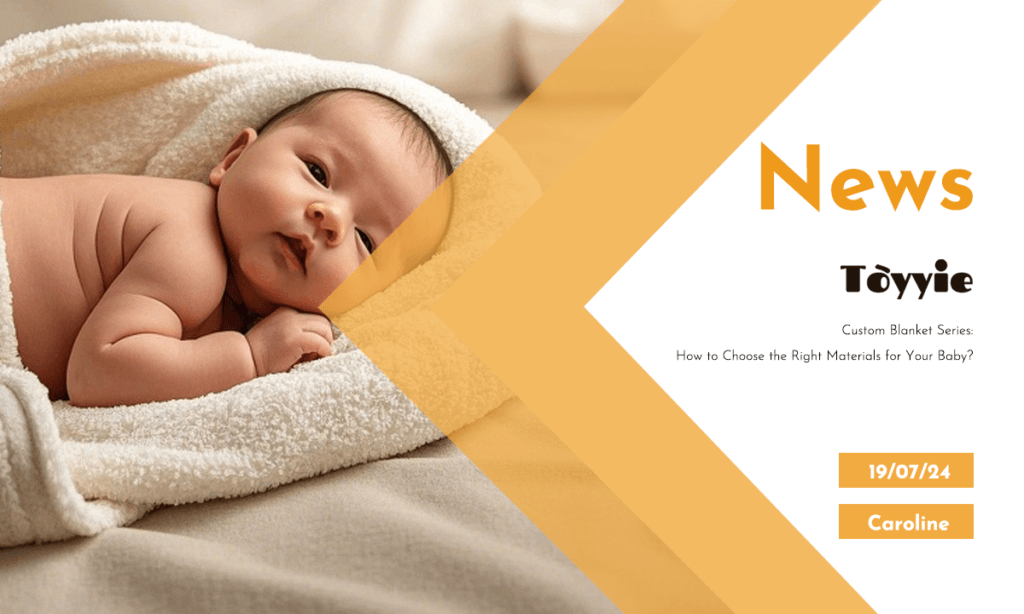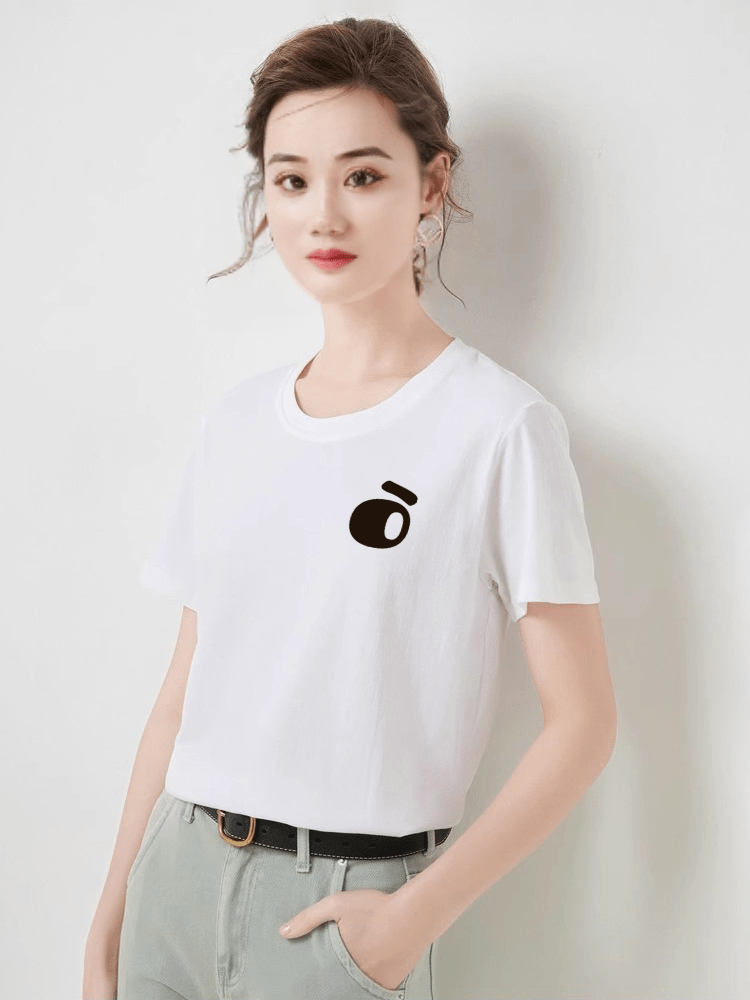The expression of love through customized products and the selection of materials🧸✨
Theme and Value🎯
Custom baby blankets are a popular choice for modern parents to express their love.
Besides allowing for personalized designs that reflect the baby’s personality and family style, custom blankets also offer significant practical value.
However, the material of the blanket directly impacts its comfort, safety, and durability. Choosing the right material can enhance the blanket’s feel, warmth, and longevity.
Therefore, understanding the characteristics of different materials is crucial.
Blog Goals📚
This blog aims to help parents understand how to choose the best material for their baby’s blanket.
We will introduce the pros and cons of various blanket materials and provide practical advice to make informed decisions when selecting a blanket for your baby.
Understanding Different Blanket Materials🧶
🌼Cotton🌼
Characteristics
Cotton blankets are loved for their natural breathability and hypoallergenic properties.
Their soft texture provides a gentle touch, ensuring the baby feels comfortable when the blanket is in contact with the skin.
Advantages
· Suitable for Sensitive Skin
Cotton blankets are perfect for babies with sensitive skin as they rarely cause allergic reactions or irritation.
The natural softness of cotton fibers reduces friction on the baby’s delicate skin, offering enhanced comfort.
· Easy to Clean and Maintain
Cotton blankets are easy to clean and maintain, typically machine washable and dryable.
The durability of cotton materials ensures they withstand repeated washing without losing their original comfort.
Use Cases
· Suitable for All Seasons
The breathability of cotton blankets makes them effective year-round.
They regulate body temperature, keeping the baby cool in warm weather and warm in cooler weather.
· Ideal for Warm Climates
In hot or warm climates, cotton blankets are especially suitable. Their excellent breathability helps prevent overheating and keeps the baby comfortable.
· Perfect for Everyday Use
Whether used at home or on the go, cotton blankets are practical.
They can serve as daily covers for the baby, such as a nap blanket or stroller cover.
🐻❄️Fleece🐻❄️
Characteristics
Fleece is known for its warmth, lightness, and excellent moisture-wicking properties.
Made from polyester fibers, it undergoes special processing to form a soft, plush surface that is both warm and lightweight.
Advantages
· Excellent Insulation
Fleece blankets effectively capture and retain body heat, creating an insulating barrier that helps keep the baby warm in cold environments.
The fluffy surface structure ensures excellent insulation, providing comfort even in low temperatures.
· Quick-Drying
Fleece material has outstanding quick-drying properties, quickly wicking away sweat and moisture.
Even when the baby is active or sweating, fleece blankets remain dry and comfortable.
· Lightweight
Despite offering excellent warmth, fleece blankets are relatively lightweight, making them easy to carry and use.
Their lightness makes them ideal for travel or outdoor use, without adding extra burden.
Use Cases
· Suitable for Cold Weather
In cold winters or low-temperature environments, fleece blankets are ideal. They provide an extra layer of warmth, ensuring the baby stays comfortable during sleep, play, or outings.
· Extra Comfort Layer
Fleece blankets can serve as an additional comfort layer over other blankets, enhancing both comfort and insulation.
For instance, at home, they can be used as bed covers or laid in strollers during outings, offering additional protection and comfort.
· Outdoor Activities
Fleece blankets are perfect for outdoor activities such as picnics, camping, or travel.
Their lightweight and quick-drying properties make them an excellent choice for outdoor use, effectively coping with various weather conditions.
🦄Minky🦄
Characteristics
· Ultra-soft, luxurious, and plush.
Minky blankets are renowned for their unique ultra-soft texture and luxurious feel.
The surface features dense plush fibers, providing exceptional comfort and warmth.
Minky fabric is typically thicker than other materials, offering better insulation while remaining lightweight.
Its plush texture makes the blanket incredibly soft to the touch and visually luxurious.
Advantages
· Extreme Comfort, Perfect for Cuddling.
The main advantage of Minky blankets lies in their unparalleled comfort and warmth.
They are perfect for creating high-comfort items such as baby blankets, cushions, and shawls.
For users seeking luxury and comfort, Minky fabric is an excellent choice. Its soft texture provides a warm, cozy feeling, ideal for cuddling and relaxation.
Use Cases
· Suitable for Cooler Weather or as a Special Comfort Blanket.
Minky blankets are perfect for cooler weather, such as in fall and winter or air-conditioned rooms.
They can be used as special comfort blankets, whether on the sofa or as part of bed linen, providing extra warmth and comfort.
Additionally, the high aesthetic appeal of Minky fabric makes it an ideal gift choice, especially for those who value texture and detail.
🎋Bamboo Fiber🎋
Characteristics
· Eco-friendly, hypoallergenic, and highly absorbent.
Bamboo fiber is a textile made from bamboo, known for its eco-friendliness and sustainability.
Bamboo grows rapidly without the need for pesticides and fertilizers, making the production process environmentally friendly.
Bamboo fiber is naturally hypoallergenic, rarely causing skin allergies.
Additionally, bamboo fiber has excellent moisture-wicking properties, quickly absorbing and evaporating moisture to keep dry.
Advantages
· Breathable and Antibacterial, Gentle for Sensitive Skin.
Bamboo fiber fabric boasts good breathability and natural antibacterial properties.
Its breathability allows air to flow through the fibers, preventing a stuffy feeling and maintaining comfort.
Simultaneously, bamboo fiber contains natural antibacterial substances that inhibit bacterial growth, keeping the fabric clean and hygienic.
The gentle texture makes it suitable for sensitive skin, especially for delicate baby skin.
Use Cases
· Ideal for Babies with Allergies or Sensitive Skin, Particularly in Warmer Climates.
Bamboo fiber blankets are perfect for babies with allergies or sensitive skin.
Due to its hypoallergenic and gentle properties, bamboo fiber provides a safe and comfortable environment for babies.
Especially in warmer climates, bamboo fiber blankets’ high moisture-wicking and breathability can effectively regulate temperature and humidity, maintaining comfort for the baby.
Whether as a summer blanket or an all-year-round item, bamboo fiber blankets are an ideal choice.
🐏Wool🐏
Characteristics
· Natural, breathable, and excellent insulation.
Wool is a natural fiber known for its superior breathability and insulation.
Wool fibers’ unique structure allows them to keep warm in cold weather and stay cool in hot weather.
Wool’s natural crimp creates numerous air pockets, providing excellent insulation while allowing air to flow, preventing a stuffy feeling.
Advantages
· Temperature Regulation, Durability.
Wool’s temperature-regulating properties are excellent, automatically adjusting to external temperature changes to provide a suitable temperature for the body.
Whether in cold winters or warm spring and fall, wool offers a comfortable temperature.
Additionally, wool fibers are highly durable, maintaining their shape and function over time without deformation or wear.
Wool also has natural stain and static resistance, making it easy to care for and maintain.
Use Cases
· Suitable for Cold Weather or as an Extra Insulating Layer.
Wool blankets are perfect for cold weather, offering superior insulation to keep warm.
Whether used at home or carried during outdoor activities, wool blankets provide excellent warmth.
Additionally, wool blankets can serve as an extra insulating layer with other beddings, enhancing warmth.
Particularly on cold winter nights, wool blankets ensure comfort and warmth for both you and your baby.
Considerations When Choosing Blanket Materials🤔
🧒Baby's Skin Sensitivity🧒
Sensitive Skin
For babies with sensitive skin, it is essential to choose hypoallergenic and soft materials.
Cotton and bamboo fiber are excellent choices.
Cotton blankets are naturally soft and breathable, not irritating sensitive skin.
Bamboo fiber is hypoallergenic and has natural antibacterial and moisture-wicking properties, providing a gentle and comfortable touch for babies.
Allergies
If the baby has allergy problems, be more cautious when selecting materials.
Opt for materials that do not easily trigger allergic reactions, such as organic cotton or bamboo fiber.
These materials are naturally non-irritating and have undergone special treatment to avoid chemical residues, ensuring the baby’s skin health.
🌤️Climate and Weather🌤️
Warm Climate
In warm climates, choosing materials with good breathability is crucial.
Cotton and bamboo fiber, with their excellent breathability and moisture-wicking properties, can effectively regulate temperature and keep dry and comfortable.
Cotton blankets are lightweight and soft, perfect for warm weather.
Bamboo fiber, with its superior moisture-wicking and antibacterial properties, is ideal for humid environments.
Cold Climate
In cold weather, choosing materials with good insulation is necessary.
Fleece and wool are ideal choices.
Fleece blankets are lightweight and warm, with quick-drying properties that keep dry in damp conditions.
Wool blankets offer excellent insulation, with their natural crimp structure creating many air pockets for warmth.
Wool also regulates temperature, ensuring comfort in cold environments.
🧺Maintenance Convenience🧺
Cleaning
For busy parents, choosing materials that are easy to clean and maintain is essential.
Cotton blankets are machine washable and easy to maintain, remaining soft and comfortable after multiple washes.
Bamboo fiber blankets are also easy to clean, dry quickly, and resist wrinkles.
Durability
Frequent washing can affect the blanket’s lifespan, so durability is an important consideration.
Wool and high-quality fleece materials are durable and withstand multiple washes without deforming or damaging.
Choosing durable materials ensures the blanket stays in good condition for a long time, providing lasting comfort for the baby.
🛌Comfort and Softness🛌
Softness
For extra comfort, consider using particularly soft materials like Minky.
Minky blankets are highly popular for their ultra-soft texture and luxurious feel, perfect for baby cuddles.
They offer the ultimate comfort experience, making them a favorite among parents.
Breathability
Ensuring that the material allows for adequate airflow to prevent overheating is crucial.
Breathable materials like cotton and bamboo fiber effectively regulate temperature, keeping the blanket dry and comfortable.
Choosing a blanket with good breathability helps provide a comfortable sleeping environment and prevents the baby from overheating.
In conclusion🎉
Selecting the right blanket material not only affects your baby’s comfort but also directly impacts their health and safety.
By considering your baby’s skin sensitivity, climate and weather conditions, maintenance convenience, and overall comfort and softness, parents can find the most suitable blanket material.
Making an informed choice ensures that your baby enjoys warmth and comfort in every season and environment.💖❄️








